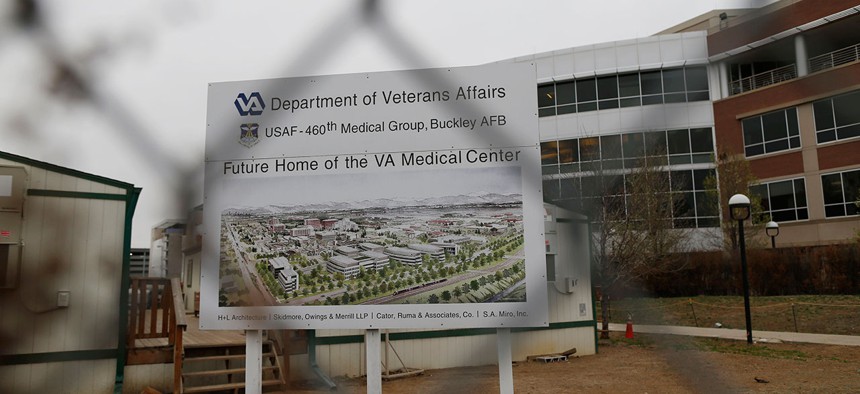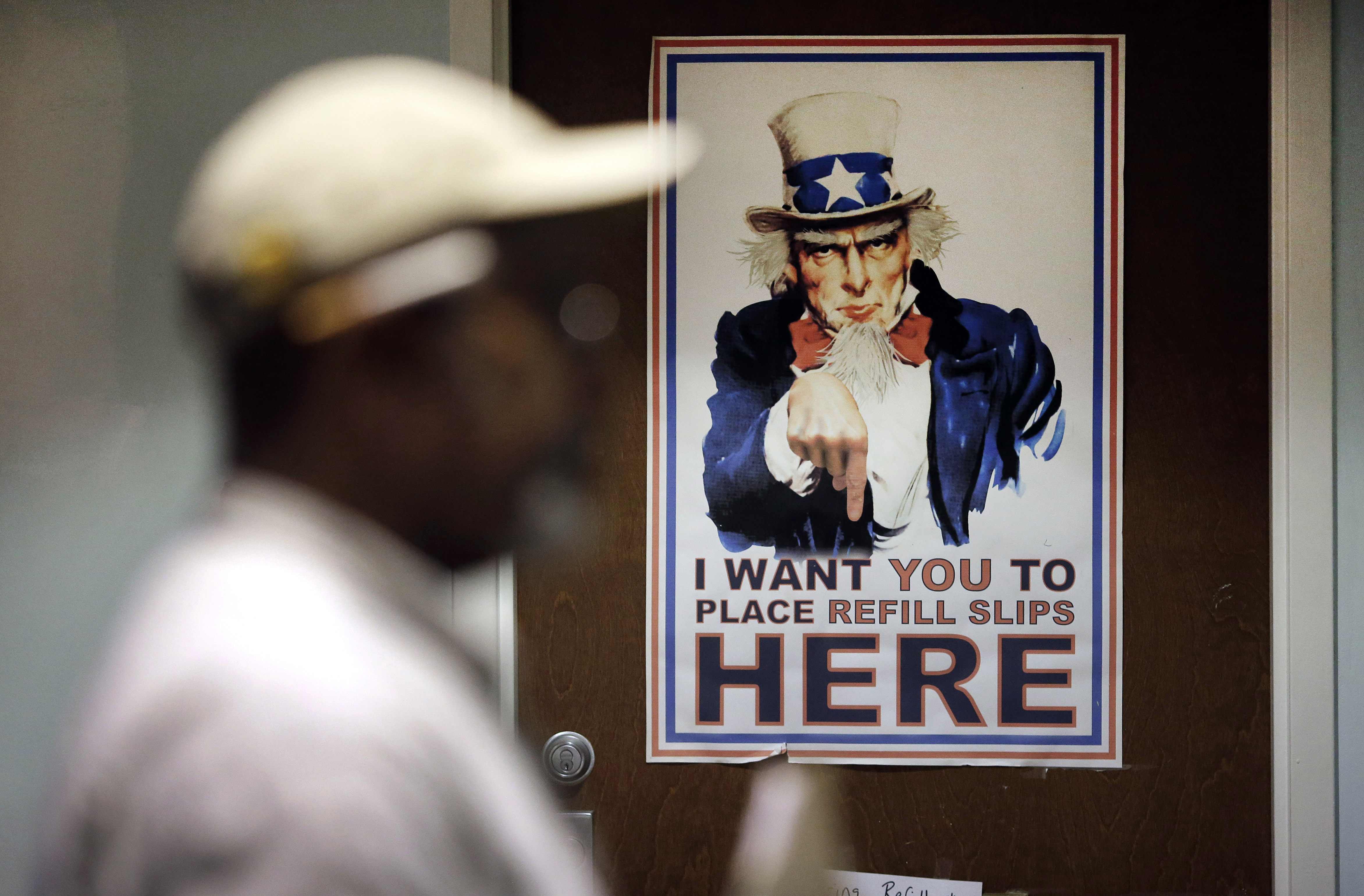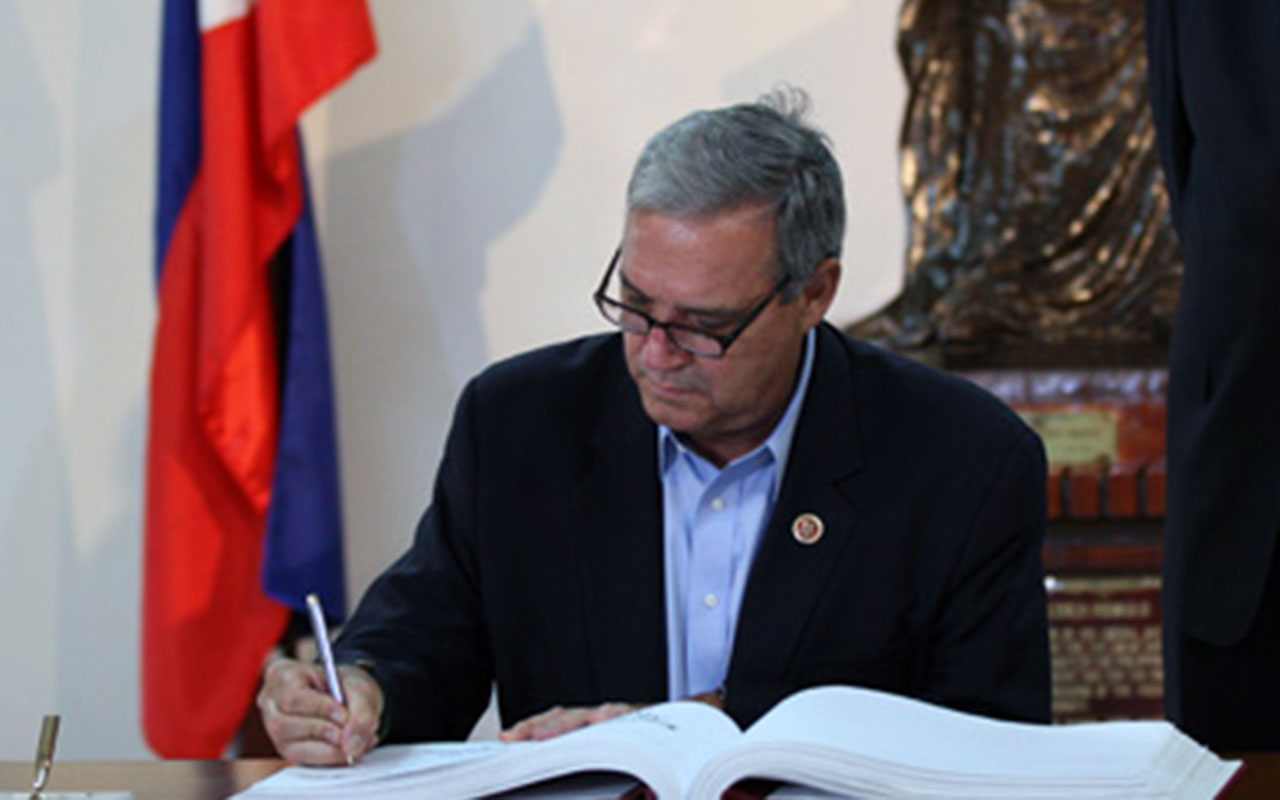
David Zalubowski/AP
Inside the Fight to Reduce the Government’s Role in Veterans Health Care
How some members of a congressionally-chartered commission could upend the conversation on veterans care.
It’s an old refrain: run government like a business. But to the naysayer, it can sound an awful lot like a much less agreeable suggestion: turn government into a business.
That’s what a congressionally-chartered commission of reformers tasked with overhauling the way the government provides health care to veterans is up against. A subgroup of that commission has proposed what its members see as a means of harvesting the ingenuity and resources of the private sector; detractors of the proposal see only an ideological ploy to shrink the government and privatize veterans care, consequences be damned.
The battle over the proposal is likely to continue until early summer, when the full Commission on Care, created by a few paragraphs in the much larger 2014 Veterans Access, Choice and Accountability Act, produces its final recommendations on better ways to deliver health care for veterans. Already, the plan has produced significant backlash in the veterans community, prompting veterans service organizations, employee unions and lawmakers themselves to weigh in.
Strawman Report
The Commission on Care has met regularly since September, but really started garnering attention in March after seven of its 15 members released their own set of recommendations for improving health care delivery for veterans. While the full commission will not issue its final report until June 30, the subgroup released its preliminary suggestions a bit early.
The objective of the so-called “strawman report” differs based on who you ask; its authors say they were simply trying to deliver policy specifics to advance the conversation, while its opponents say the group acted in poor faith and outside the public spotlight to offer recommendations that were self-serving, politically motivated and harmful to veterans.
The content of the report itself is also a point of controversy. Opponents characterize it as a full-scale call for privatizing VA health care, while supporters say it simply offers veterans more choices and better integrates government and privately run systems. What is clear from the report is a commitment to phasing out the dominance of government-run facilities in providing care to veterans.
The report repeatedly suggests the Veterans Health Administration is broken and in “immediate need of a bold transformation.” Namely, the authors said, the Veterans Health Administration should become “primarily a payor” entity.
The report spells out a panoply of inefficiencies that bog down VHA: a soon-to-be declining veteran population that uses VA facilities for only some health care needs; bureaucratic hiring practices that leave critical positions unfilled; Congress serving as a biased board of directors; a dilapidated network of buildings not necessarily located where veterans live; poorly designed and outdated information systems; and an overly burdensome process for veterans looking to take advantage of existing care in the community options.
To kick off the “bold transformation,” the strawman report calls for a systematic closure of facilities deemed underutilized or obsolete. Those would be just the first to be “transitioned.”
“If veteran choice dictates it over time, the long-term goal of the transformation is the total transition to community care,” the authors of the report wrote.
If any of that sounds like privatization, chalk it up to “inartful” phrasing, according to Darin Selnik, one of the commissioners who worked on the report.
“The first draft is going to be an awkward draft,” said Selnick, a former VA political appointee under President George W. Bush and a senior adviser to the conservative-aligned Concerned Veterans for America.
The commission is tasked with creating a roadmap for veterans health care over the next 20 years, and Selnick said his group’s prognosis is simply a “trend analysis” of what is likely to occur over that timeframe. Once 51 percent of appointments take place outside of VA-owned facilities, he explained, the department would be “primarily a payor” -- but that is a far cry from privatization.
“No one is trying to eliminate any needed facilities or outpatients, nor are they trying to close them all down,” Selnick said, adding the goal is to find the “equilibrium of what the veterans population is going to be, what’s the footprint they’re going to need.”

The report’s proposals would upend VA’s management structure, creating one office for community care and another for internal services. A separate entity for “transformation management” would be created. Construction on any new facilities and renovations on any existing ones would cease, and VA would begin a process akin to the Pentagon’s controversial Base Realignment and Closure procedure. VHA enrollees would receive a “veterans card” that would provide them access to private care around the country. To administer the integrated system, the report advises VA to follow Medicare’s best practices.
The strawman authors call for the General Services Administration to unload what will become excess property, and say VA employees would have a relatively easy time either relocating to other VHA facilities or joining the private sector. The department’s research functions could be moved to the National Institutes of Health, the report suggests. Private health care providers would receive a financial incentive to see veteran patients.
The plan is not yet fully fleshed out. The group says, for example, “arrangements for pharmacy [benefits] will be developed.” The strawman report calls for “impeccable business practices” in implementing the plan that should be modeled after “the best in the commercial world.”
The authors make one promise quite clear, however: “No veteran should receive less care than is being offered now.”
Backlash
The strawman group pushed its proposal at a public commission meeting in March, and the opposition kicked into gear almost immediately.
Before even getting to the content of the proposal, opponents criticized the process by which it was drafted. Selnick said discussions took place in one of the commission’s many working groups, and that he received the blessing of chairwoman Nancy Schlichting to commit his and others’ ideas to paper. To some, the group’s work still does not pass the eye test.
“This proposal was done in secret, with only seven instead of the full 15” commissioners, said Garry Augustine, executive director of Disabled Veterans of America. DAV has joined seven other veteran service organizations, including the American Legion and Veterans of Foreign Wars, in writing a letter to Schlichting opposing the strawman report’s proposals.
Augustine served in Vietnam, where he was injured by an improvised explosive device. Upon returning stateside, he received initial treatment through the Defense Department at Walter Reed Medical Center. He still required long-term care, however, and leaned on VA to guide him through his specialized needs.
“If I was just given a card and told to go get this taken care of, I would’ve been lost,” Augustine said. By putting more of a focus on private care, VA would rob future veterans of the all-inclusive assistance he received from vocational training to educational assistance to rehabilitation, he said.
In Augustine’s reading, the strawman report would “get rid of VA in 20 years.” Another major issue with that proposition, he said, is that VA hospitals and clinicians are well equipped and trained to deal with issues specific to veterans needs.
“Some of these injuries don’t show up in the private sector that often,” he said. Augustine added that he does not philosophically oppose augmenting integrated care, but cautioned that the providers must become familiar with the intricacies of receiving government reimbursements before accepting veteran patients.
Marilyn Park, a legislative representative at the American Federation of Government Employees, which represents 270,000 VA workers, called the proposal “radical” and “extreme.” She said the recommendations would result in a “major dismantling of the VA as we see it now.”
Park added that one commissioner, upon hearing the proposal, said: “I was willing to compromise but there is not compromise here.”
The groundswell of opposition to the report grew so loud that Schlichting issued a letter to assuage concerns the full commission was endorsing the strawman report’s proposals. The chairwoman called the recommendations just some “on a range of possibilities the commissioners are considering.”
“The scenario presented in [the strawman report] is one of several that have been proposed,” Schlichting said. “As the term ‘strawman’ implies, the document was created by a subset of commissioners to describe their personal ideas, which ultimately facilitated and focused public discussion and prompted new proposals. It was not presented as a final report.”
Undue Influence?
Criticism of the report is aimed as much at the authors and their motives as the content itself.
Selnick’s CVA has come under fire -- including from Sen. Bernie Sanders, I-Vt., in a presidential debate -- for ties to Republican mega-donors Charles and David Koch. Several of the strawman authors work for private sector health care providers, which detractors say stand to benefit from fewer government-run health care facilities.
“Just the objective appearance,” Augustine said, “you have concerns about what their intent is.”
On top of those criticisms, privatization opponents have questioned the congressional influence on what was created to be an independent commission. Rep. Jeff Miller, R-Fla., chairman of the House Veterans’ Affairs Committee and a co-author of the law that created the commission, wrote a letter to Schlichting lampooning one of the commissioners for his role in a Washington Monthly story downplaying the impact of the VA waitlist scandal.

Miller also attended the last commission meeting, where multiple attendees described his demeanor to Government Executive as “angry.” The chairman, a consistent thorn in the side of the Obama admiration’s VA, told the commissioners he was looking forward to their “collective wisdom” on how to expand the private sector’s role in providing health care to veterans.
“To be veteran-centric,” Miller said, “we must allow veterans to seek care outside of the department’s walls.”
VA has, in Miller’s view, been reluctant to embrace change. Miller fought to include a provision allowing veterans living far from a VA facility to receive government-funded private care.
“For far too long, VA has been resistant to using that authority and insistent on care being provided by VA providers in a VA medical facility coordinated and approved by VA bureaucrats -- even if that meant veterans had to travel long distances and wait in long lines,” Miller said at the March meeting. “That is not being veteran-centric; that is being VA-centric.”
That language, which Miller has used for years, mirrors some pieces of the strawman report.
“The delivery of health care to veterans -- whether by VHA or community providers -- should be veteran centric,” the report reads. “It should not be ‘bureaucracy centric.’ ”
Before the last public meeting, Selnick met with Miller at the chairman’s office. While they discussed commission business, Selnick said the timing was coincidental and set up because of the commissioner’s role at CVA.
A Miller aide told Government Executive that the chairman did not endorse any specific proposal, and there was nothing unusual about his appearing at the commission meeting. Rep. Beto O’Rourke, D-Texas, has also addressed a meeting to discuss some of the approaches taken at the VA hospital in his district.
“Chairman Miller is very consistent in his view that a VA system in which private sector provider networks support -- not supplant -- VA-provided care will best serve America’s veterans,” the aide said. “This is precisely the view of most members of Congress and of VA, itself. The notion that espousing this widely accepted mainstream view is somehow nefarious is nothing more than a ridiculous conspiracy theory expressly designed to influence the commission’s work.”
Next Steps
With only seven of the commissioners so far signing on to the strawman report proposals, it is unclear if the subgroup’s recommendation will be included in the final report from the full commission this June. Selnick says the commission is, for now, focusing on reaching a consensus, and has not yet decided how to proceed if there is not universal agreement.
To AFGE’s Park, the commission has already come too far to turn back, noting only a select few of the 15 members of panel have openly voiced opposition to moving toward making VA primarily a reimbursement office.
“I’d be surprised at this point if they don’t get most of their proposals into the final report,” Park said. “It’s going to prevail.”
Park may find an ally in the chairwoman of the commission, who has embraced more integrated care but not doing away with all VHA facilities. A payor-only recommendation, Schlichting said in a recent letter to fellow commissioners, would lead to the entire report being ignored.
“A recommendation of that kind would not only provoke a strong backlash from stakeholders,” Schlichting wrote, “but further demoralize VHA staff and exacerbate recruitment and retention challenges.”
After the commission issues its final report in June, it will present its recommendations to the president, who will decide which actions he can take unilaterally and what requires legislation. The Choice Act compels the president to act -- or submit proposals for Congress to act -- on the recommendations, so long as they are “feasible” and “advisable.” While that leaves some wiggle room for the White House to dismiss objectionable proposals, the burden is on the Obama administration to prove the suggestions would be too difficult to carry out.
Augustine’s caution on what might result from the final report stems from surveys of DAV members, which have shown about 80 percent of those interacting with VHA report positive experiences. That finding mirrors what has become a common refrain: Veterans like the care they receive from VA, once they actually get it. To DAV and the VSOs, that does not mean things are perfect.
“We’re united in trying to save and fix the VA,” Augustine said. “We understand it has problems.”
While Selnick has called for bolder action -- and he refuses to make any promises about what might come down the road -- he wants to mitigate the fears that have surfaced since his group released its report.
“What will be there in 20 years will be what the veterans decided they wanted,” he said. “If they want VA, the physical facility will be there. The clinicians will be there. VHA will never go away.”
CLARIFICATION: One of the quotes from AFGE's Marilyn Park has been updated to clarify that she was paraphrasing a commissioner.







